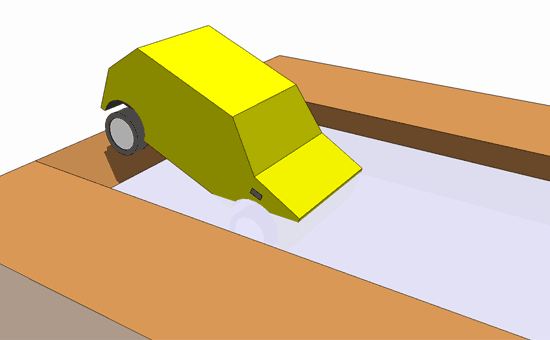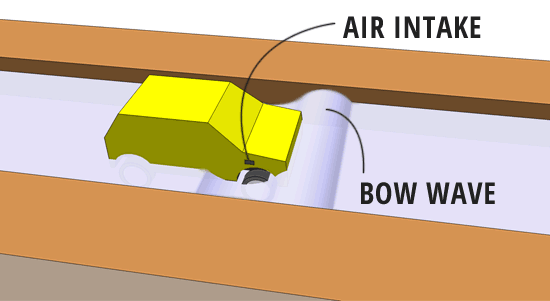Driving in deep water
Wading though deep water can be one of the most enjoyable and exciting aspects of off-road driving, however it can also be dangerous and may damage your vehicle. Follow our guide below to minimise the risk and increase your chances of getting to the other side. Please note, this article is intended for those with a 4×4 vehicle and decent off-road driving experience. Rules of thumb
- Check your vehicle’s maximum wading depth
- Recce the crossing on foot
- Consider the environmental impact
- Select a gear which reduces the chances of stalling
- Use a bow wave to artificially reduce the depth of the water
- Keep moving and don’t let the engine stop
- Avoid flowing water unless you know what you are doing
Check your maximum wading depth
Wading depth is set by the manufacturer of your vehicle and is determined by a number of crucial factors. These include the location of sensitive electronics, the air intake, and other venerable areas. Often the manufacturer will assume you’ll only be wading for a few minutes, so if you intend on regularly crossing rivers some additional preparation may be required. Consult an expert if you’re considering a serious expedition. It’s a good idea to have a reference point on the vehicle as an indication of the wading depth – usually the top of the wheel rim is a safe bet, but consult your handbook for more information.
4×4 Accessories
The following accessories may be required for sustained wading in deep water:
- Wading plugs or breathing tubes for the gearbox and differentials to prevent water ingress
- Sealed air intake snorkel to prevent water entering the engine
- Radiator barrier to lower the water level in the engine bay
- Splash baffles can prevent the fan throwing water everywhere in your engine bay
Preparation
- Disconnect or disable fans if necessary to prevent damage to the fan blades and reduce the amount of water thrown around inside the engine compartment.
- Ensure you have no fluid leaks which could be potentially hazardous for the aquatic wildlife.
- Pre-attach a tow rope to your recovery points if you think there is any risk of getting stuck – attach on the side of the vehicle you’re most likely to be recovered from.
- Perform a recce to determine the best route.
Recce
If you are in doubt about your ability to cross, get out and walk the route (fishing waders come in handy here). Check the ability of the ground to provide traction and support and look around for hidden obstacles. Use a marshal if necessary to provide a visual indication of any hazardous areas or hidden obstacles. If you intend on crossing flowing water, check the speed of the flow – remember that a car will float and can get carried away downstream pretty easily so don’t attempt this unless you are very experienced. If in doubt, abort the crossing and find another way round!
Technique
Whether you’re entering a river, lake or a deep trough, you’ll find most areas of water have a steep entry (A) and exit point (C) and submerged ground under the water which may or may not provide decent traction and support (B).
Entering the water
When you descend the slope it’s sensible to use exactly the same technique described on our hill descent article. Enter the water gently in a low gear to prevent a huge splash. Then accelerate slightly and change up if necessary when you’re on a flat surface.
On the flat
Select a gear which provides a decent amount of traction, but reduces the chance of engine stall, and keep the engine in the power bend. Second gear in low range (if fitted) is usually about right, but if you don’t have low range it’s probably best to stick to first. By driving slowly and steadily (jogging pace) through the water you’ll find that a bow wave naturally forms in front of the car. This is useful as it artificially lowers the level of the water at the front of the vehicle, crucially around the engine bay and air intake.
Follow the wave and try to keep it about a metre in front of your vehicle for the best results. This provides an additional layer of protection for sensitive vehicle components, however if you stop this effect is cancelled out immediately. Ensure you can keep going once you’ve entered the water – the what you should check on the recce, or altenatively follow the path of a previsouly successful vehicle. Don’t let the engine stall – while the engine is running the gas pressure will prevent water entering the exhaust pipe (even if it’s completely submerged). But if you turn the engine off or stall, the rapidly cooling gas will suck water up towards the engine and can clog up and damage the catalytic converter. If you do stall, try to restart the engine as quickly as possible and you should be ok, but if it won’t start wait to be recovered to prevent costly engine repairs.
Exiting the water
When you’re getting close to the other side it’s a good idea to ease off the throttle – as the bow wave hits the bank it will come back towards the car and can splash well over the bonnet if speed isn’t reduced. Climb out of the water using the techniques outlined in our article on climbing hills and you’ve made it! Reconnect the fan if necessary and continue on your adventure.



Thank you again for this informative guide.